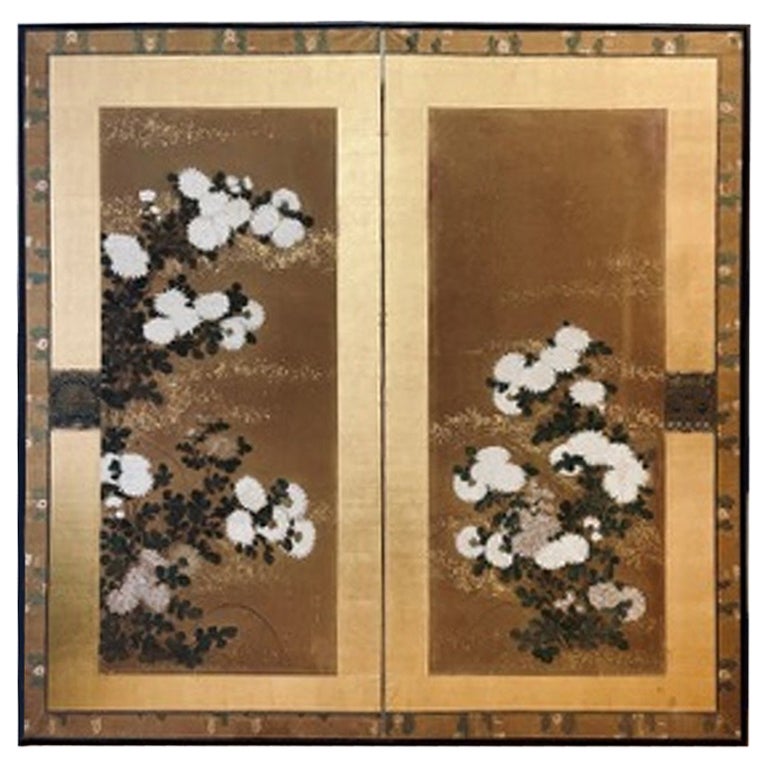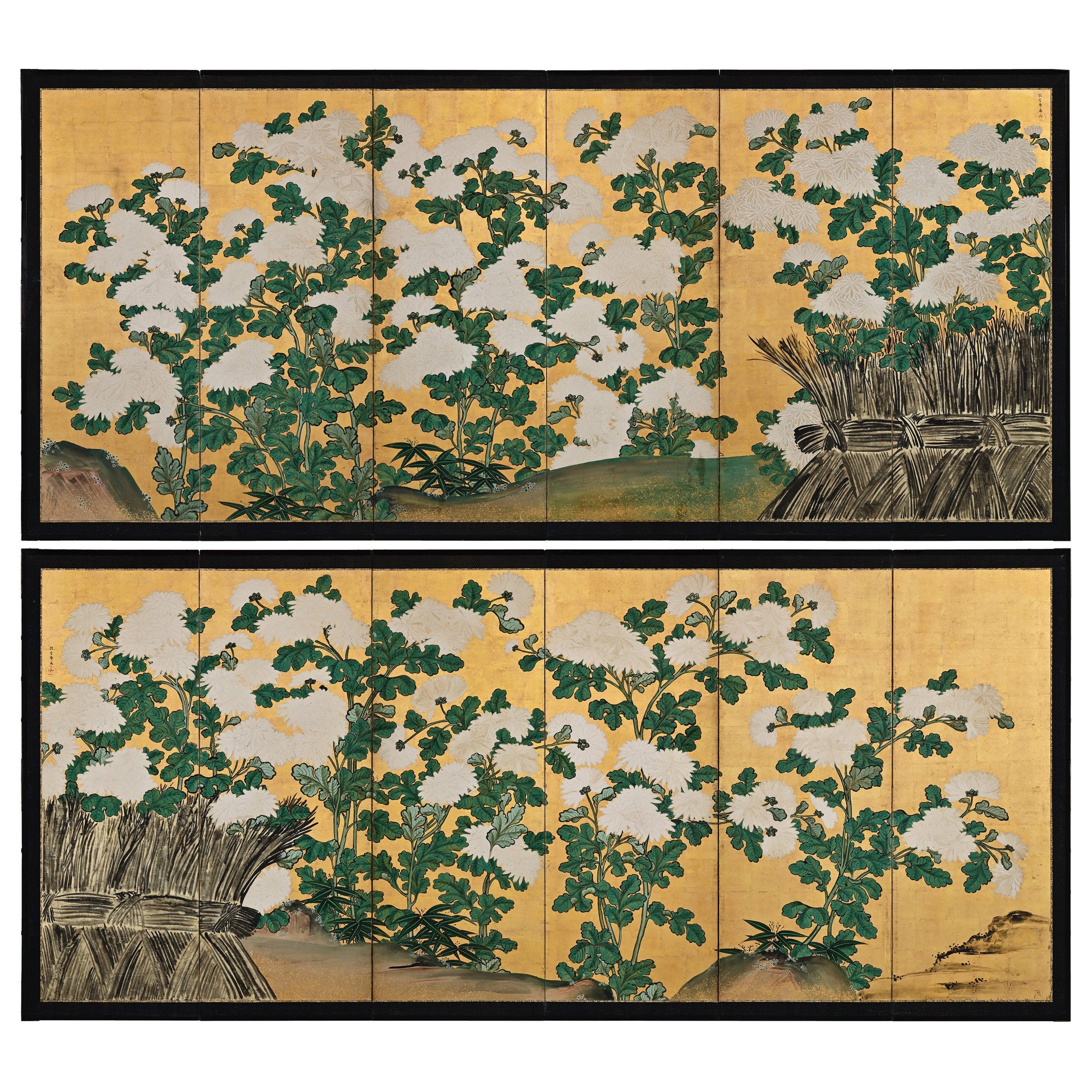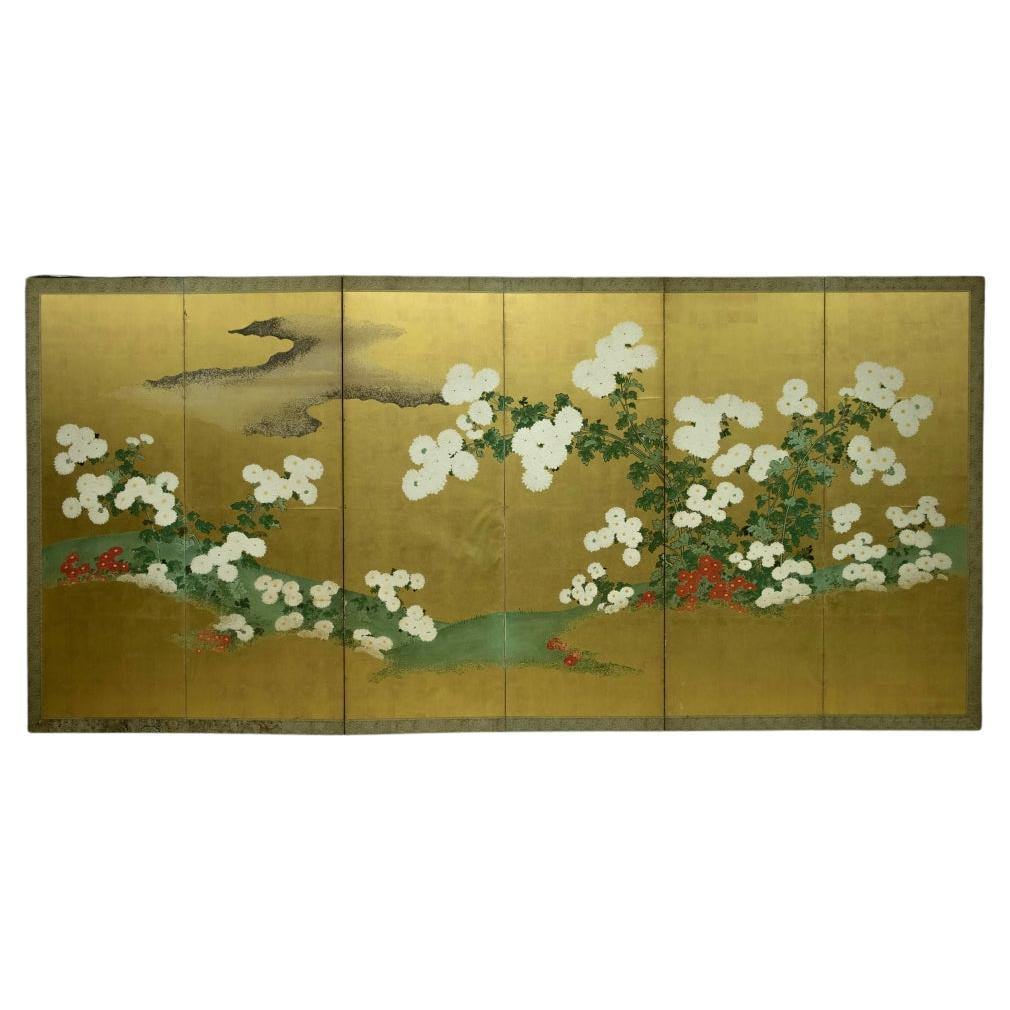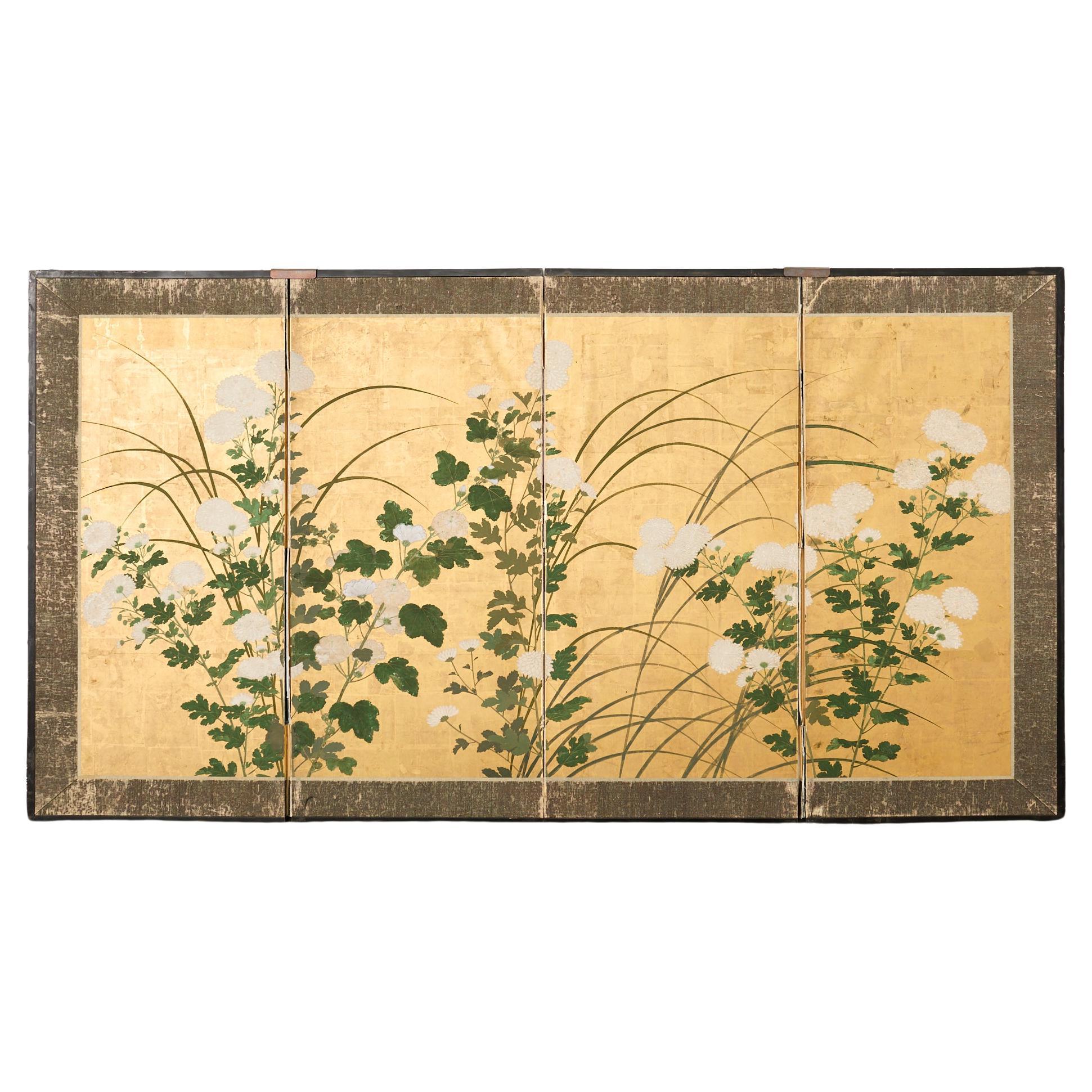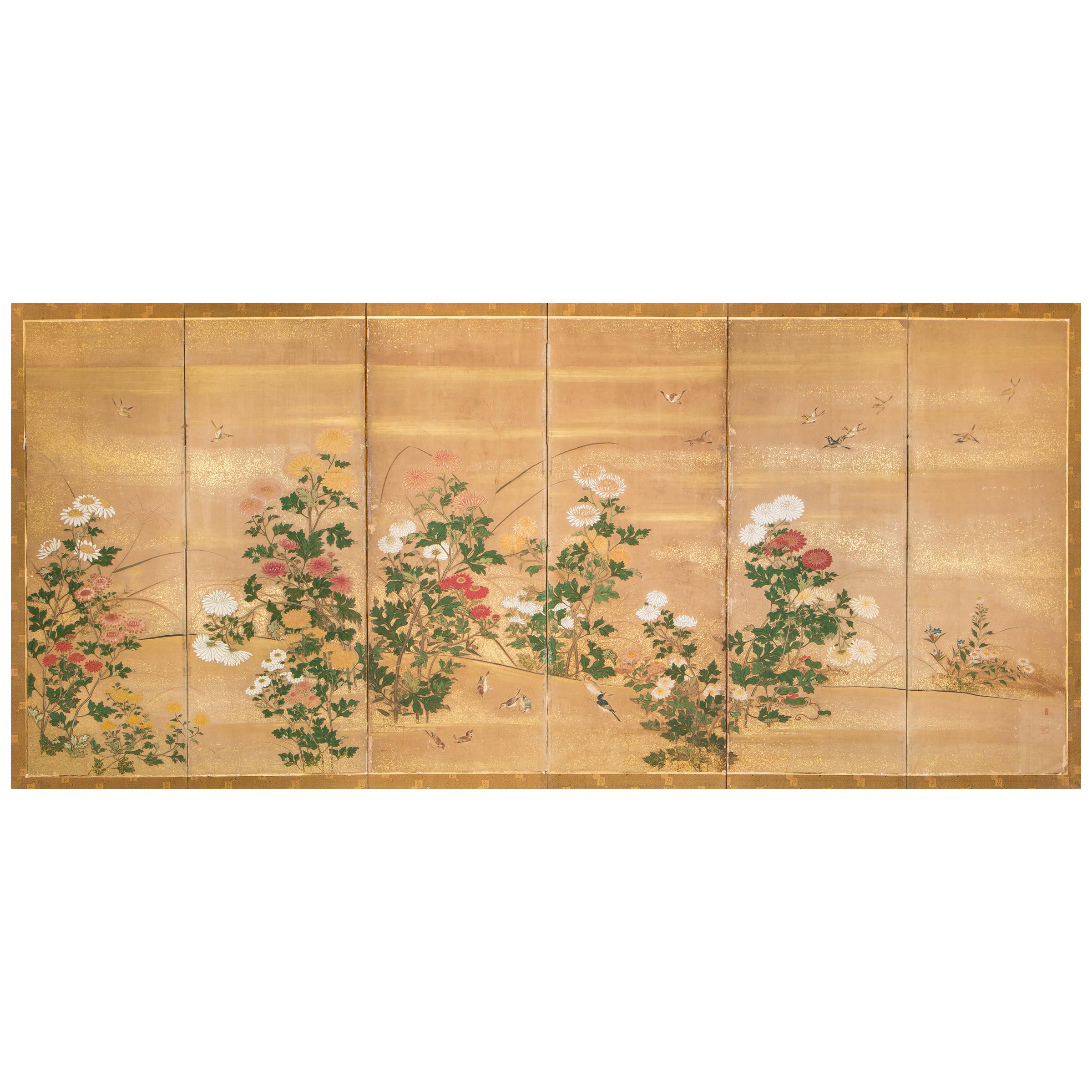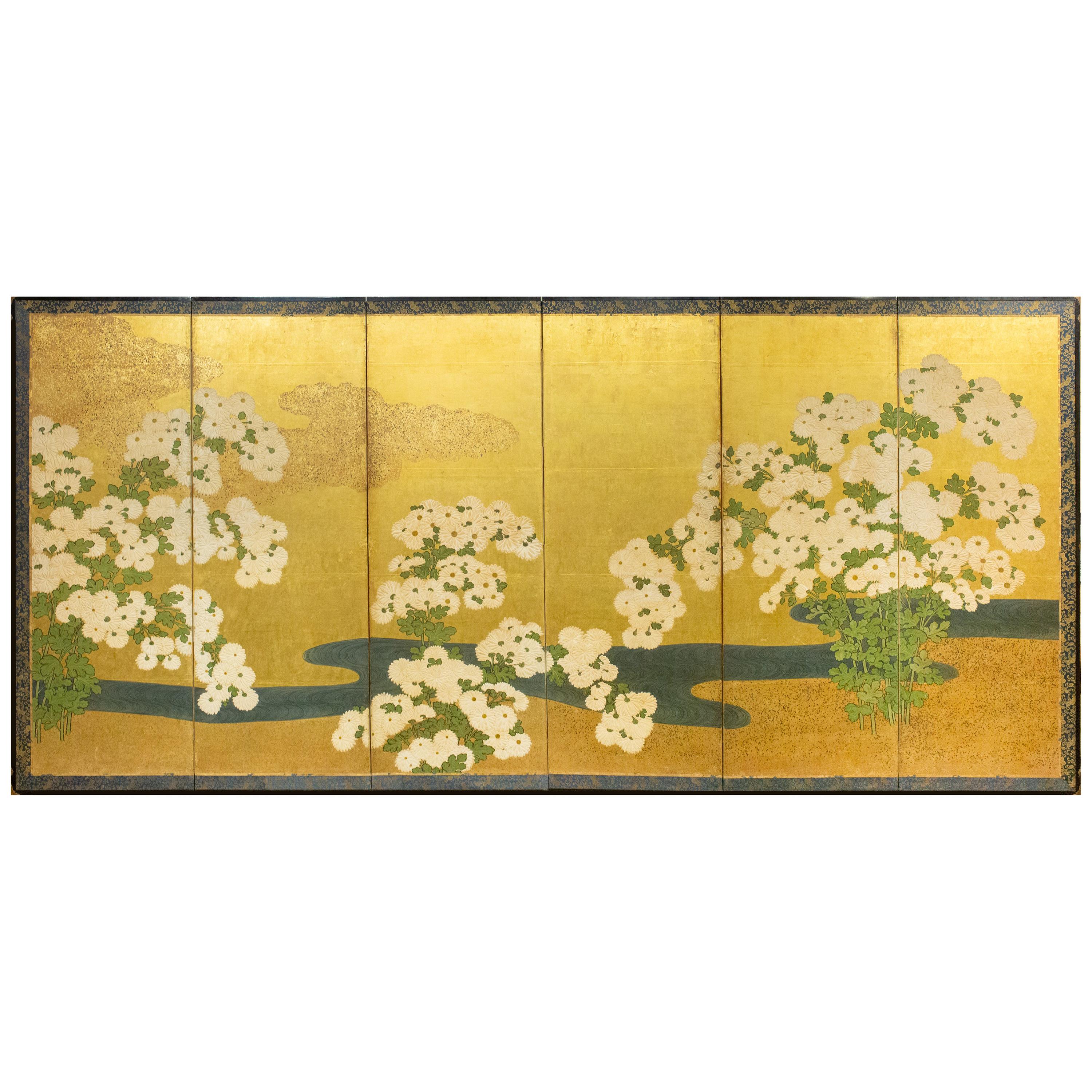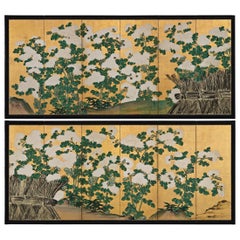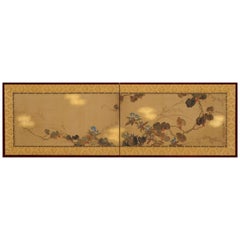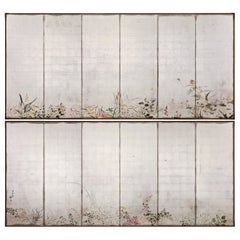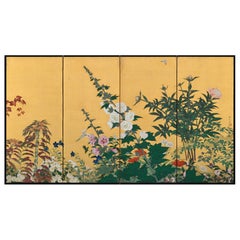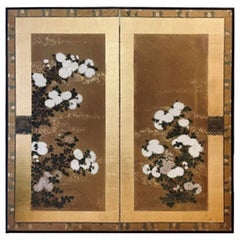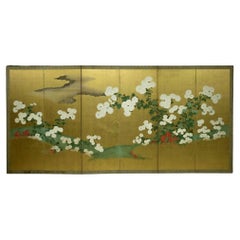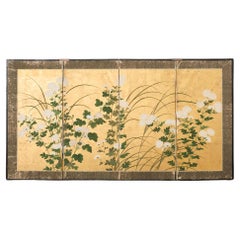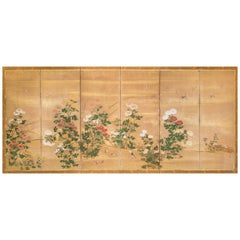Objekte ähnlich wie 18th Century Japanese Rinpa Screen. White Chrysanthemums. School of Korin.
Möchten Sie mehr Bilder oder Videos?
Zusätzliche Bilder oder Videos von dem*der Anbieter*in anfordern
1 von 10
18th Century Japanese Rinpa Screen. White Chrysanthemums. School of Korin.
27.858,14 €
Angaben zum Objekt
School of Ogata Korin
White Chrysanthemums
18th Century, Edo period.
A two-panel Japanese screen. Ink, color, gofun and gold leaf on paper.
Dimensions: H. 171 cm x W. 188 cm (67.5” x 74”)
On this two-panel Japanese screen we see blooming chrysanthemums, a flower which embodies the essence of autumn in Japan. Here the traditional floral theme has been simplified and stylized. The bright colors and asymmetrical composition against the delicate gold leaf create a luxurious and ornate work of art. Its background, a strikingly patinated grid of gold leaf, denies any sense of place or time and imbues everything with an ethereal glow. The leaves and stems of the plants are nothing more than pools of mottled color and ink without any outline whatsoever. These are typical Rinpa adaptations of traditional ink painting methods; tarashikomi, or diluted washes of color blended while very wet, and mokkotsu, or “bonelessness,” which creates forms without exterior outlines. The relief work of the rounded flower petals has been obtained by the moriage process (a mixture based on ground shells modeled on the surface of the paper).
On the lower right of the screen, the siganture “Hokyo Korin Jakumyo” and the “Hoshuku” seal can be read. Korin is Ogata Korin, famed for the Irises (Nezu Museum) and Red and White Plum Blossom (MOA Museum of Art) folding screens, both National Treasures. Korin worked in both Kyoto and Edo in the mid-Edo period. Korin was using the art name “Jakumyo” just after he received the Hokyo level, which was in 1701.
This particular screen was published in May of 1961 in the Japanese Sansai Fine Art Magazine*. An in depth article accompanies the photograph of the screen and and a photograph of the signature and seal. This article devotes much of its body to discussing the moriage technique, how it enlivens the chrysanthemum flowers and Korin’s specific skill in using the technique. The article goes on to discuss the most famous works of Korin, utilizing this technique, which were known at the time. Specifically a two-panel screen held in the Honolulu Museum which was discovered in the store-house of Takahashi Soan. A two-panel screen pair which the Nakano family own. A two-panel screen pair with chrysanthemums in moriage in fan designs owned by the Nomura family. Also a small folding screen featuring chrysanthemums held in the Yamato Bunkakan. The article goes on to say that this particular two-fold screen came from the Nijo family. Korin is known to have had a strong connection with the aristocratic Nijo family. The article explains that Korin received a lot of favors from the Nijo family and that this screen would have been gifted to them.
Since that time the Honolulu screen has been amended to ‘attributed to Ogata Korin’ and I do not know further details of the other 3 screens. Other Chrysanthemum screens utilizing the moriage technique signed and sealed Korin are held in the Guimet Museum, Smithsonian National Museum of Asian Art, Cleveland Museum of Art and the Okada Museum. The pair held in the Cleveland Museum of Art is listed as “Possibly by Ogata Korin”. The pair in the Smithsonian National Museum of Asian Art are dated to the 19th century with no attribution. The Suntory Museum holds a two-panel screen “Flowering Plants in Autumn” which features chrysanthemums in the moriage technique. This work is also “attributed to Ogata Korin”.
It is quite clear that there are serious difficulties in authenticating all of the chrysanthemum screens bearing the signatures and seals of Ogata Korin. The work being offered here clearly dates to the 18th century though is not by the hand of Ogata Korin himself. Perhaps ‘Studio of Korin’ would be appropriate. Perhaps ‘School of Korin’ would be appropriate.
*美術雑誌 三彩 1961(昭和36)年5月 138号
- Maße:Höhe: 171,45 cm (67,5 in)Breite: 187,96 cm (74 in)Tiefe: 1,91 cm (0,75 in)
- Stil:Edo (Aus dem Zeitalter)
- Materialien und Methoden:
- Herkunftsort:
- Zeitalter:
- Herstellungsjahr:Circa 1750
- Zustand:Abnutzung dem Alter und der Nutzung entsprechend.
- Anbieterstandort:Kyoto, JP
- Referenznummer:1stDibs: LU2472343391742
Anbieterinformationen
5,0
Anerkannte Anbieter*innen
Diese renommierten Anbieter*innen sind führend in der Branche und repräsentieren die höchste Klasse in Sachen Qualität und Design.
Gründungsjahr 2001
1stDibs-Anbieter*in seit 2016
72 Verkäufe auf 1stDibs
Typische Antwortzeit: 16 Stunde
- VersandAngebot wird abgerufen …Versand von: Kyoto, Japan
- Rückgabebedingungen
Einige Inhalte dieser Seite wurden automatisch übersetzt. Daher kann 1stDibs nicht die Richtigkeit der Übersetzungen garantieren. Englisch ist die Standardsprache dieser Website.
Authentizitätsgarantie
Im unwahrscheinlichen Fall eines Problems mit der Echtheit eines Objekts kontaktieren Sie uns bitte innerhalb von 1 Jahr für eine volle Rückerstattung. DetailsGeld-Zurück-Garantie
Wenn Ihr Objekt nicht der Beschreibung entspricht, beim Transport beschädigt wurde oder nicht ankommt, kontaktieren Sie uns bitte innerhalb von 7 Tagen für eine vollständige Rückerstattung. DetailsStornierung innerhalb von 24 Stunden
Sie können Ihren Kauf jederzeit innerhalb von 24 Stunden stornieren, ohne jegliche Gründe dafür angeben zu müssen.Geprüfte Anbieter*innen
Unsere Anbieter*innen unterliegen strengen Dienstleistungs- und Qualitätsstandards, wodurch wir die Seriosität unserer Angebote gewährleisten können.Preisgarantie
Wenn Sie feststellen, dass ein*e Anbieter*in dasselbe Objekt anderswo zu einem niedrigeren Preis anbietet, werden wir den Preis entsprechend anpassen.Zuverlässige weltweite Lieferung
Unsere erstklassigen Versandunternehmen bieten spezielle Versandoptionen weltweit, einschließlich individueller Lieferung.Mehr von diesem*dieser Anbieter*in
Alle anzeigenPaar japanische Paravents aus der Mitte des 18. Jahrhunderts, einhundert Blumen, Chrysanthemen
Omori Soun (geb. 1704)
Chrysanthemen - Einhundert Blumen
Ein Paar japanischer Paravents mit sechs Falten. Tusche, Farbe, Gofun und Blattgold auf Papier.
Dieses Paar japanischer Pa...
Kategorie
Antik, Mitte des 18. Jahrhunderts, Japanisch, Edo, Gemälde, Leinwände un...
Materialien
Blattgold
Japanische Leinwandmalerei:: frühes 19. Jahrhundert:: Herbstblumen von Sakai Hoitsu
Ein zweifacher japanischer Schirm des Künstlers Sakai Hoitsu aus der Rimpa-Schule (1761-1828), Japan, 19. Jahrhundert, Edo-Periode.
Dieser kleine japanische klappbare Paravent, be...
Kategorie
Antik, Frühes 19. Jahrhundert, Japanisch, Edo, Gemälde, Leinwände und Ra...
Materialien
Holz, Seide
Japanische Silberschirme von Isoi Joshin, Flowers of the Four Seasons, um 1930
Blumen der vier Jahreszeiten
Isoi Joshin (1883-1964)
Ein Paar japanische Paravents mit sechs Tafeln
Tusche, Pigment, Lack und Blattsilber auf Papier
Inschrift: Isoi Jo
...
Kategorie
Mitte des 20. Jahrhunderts, Asiatisch, Showa, Gemälde, Leinwände und Rau...
Materialien
Blattsilber
Japanische Leinwand aus dem frühen 20. Blumen der Four Seasons.
Anonym
Blumen der vier Jahreszeiten
Ein japanischer Bildschirm mit vier Feldern. Tusche, Gofun und Pigmente auf Blattgold.
Dieser japanische Paravent ist eine reiche visuelle Feier...
Kategorie
Frühes 20. Jahrhundert, Japanisch, Taisho, Gemälde, Leinwände und Raumte...
Materialien
Blattgold
Japanischer Kirschblütenholz-Raumteiler des frühen 20. Jahrhunderts von Kano Sanrakuki
Kirschblüten
Kano Sanrakuki (1898-1981)
Showa-Periode, um 1930
Japanischer 2-Panel-Bildschirm
Farbe, Gofun und Blattgold auf Papier
Vor einem Hintergrund aus Blattgold...
Kategorie
Frühes 20. Jahrhundert, Japanisch, Showa, Gemälde, Leinwände und Raumteiler
Materialien
Blattgold
Japanisches Paravent-Paar aus dem 19. Jahrhundert. Blumen und Vögel der vier Jahreszeiten.
Blumen und Vögel der vier Jahreszeiten
Ein Paar japanischer Paravents mit sechs Falten. Tusche, Farbe, Gofun und Gold auf Papier.
Zweite Hälfte des 19. Jahrhunderts
Ein Paar mittelgroße japanische Paravents aus der zweiten Hälfte des 19. Jahrhunderts. Mit präzisem Pinselstrich, akribischer Kompositionsplanung und atemberaubender Farbgebung hat der Künstler eine komplizierte und sehr lebendige Naturszene dargestellt. Auf den großflächigen Leinwänden wird die Bewegung der Jahreszeiten durch eine enorme Anzahl von stark verwobenen floralen Motiven dargestellt. Die Fülle der blühenden Blumen beginnt auf dem rechten Bildschirm mit dem überragenden Kirschblütenbaum und lenkt die Aufmerksamkeit des Betrachters nach links. Der Sommer wird vielleicht am besten durch die Pfingstrosen definiert, der Herbst durch das Pampasgras und die Chrysanthemen und der Winter durch die Kamelien. Dazwischen blüht eine Vielzahl von Saisonblumen, die entlang der Ufer des sanft fließenden Baches spektakulär aussehen. Zu den abgebildeten Pflanzen...
Kategorie
Antik, Spätes 19. Jahrhundert, Japanisch, Meiji-Periode, Gemälde, Leinwä...
Materialien
Holz, Papier
Das könnte Ihnen auch gefallen
Japanische Edo-Periode Zwei-Panel-Bildschirm mit Chrysanthemen, ca. 1750
Japanische Edo-Periode Zwei-Panel-Bildschirm mit Chrysanthemen, ca. 1750
ÜBER
Diese Leinwand ist in der Tat ein Meisterwerk an Design und Komposition mit einem goldenen Rah...
Kategorie
Antik, 19. Jahrhundert, Japanisch, Japonismus, Gemälde, Leinwände und Ra...
Materialien
Holz
Chrysanthemenblütenschirm der Rinpa-Schule aus der späten Edo-Zeit
Von Rimpa School
Chrysanthemenblütenschirm der Rinpa-Schule aus der späten Edo-Zeit
Zeitraum: spätes Edo, frühes 19. Jahrhundert
Größe: 364 x 172 cm (143 x 67 Zoll)
SKU: PTA13
Dieser exquisite Rinp...
Kategorie
Antik, 18. Jahrhundert, Japanisch, Edo, Gemälde, Leinwände und Raumteiler
Materialien
Papier
Japanischer Edo-Raumteiler mit vier Tafeln und weißen Chrysanthemen mit Blumenmuster
19. Jh. Außergewöhnlicher japanischer Byobu-Schirm aus der späten Edo/frühen Meiji-Periode mit vier Tafeln, auf denen blühende weiße Chrysanthemen im Moriage-Stil (Pigmentmalerei) da...
Kategorie
Antik, 19. Jahrhundert, Japanisch, Edo, Gemälde, Leinwände und Raumteiler
Materialien
Messing, Blattgold
Sechsteiliger japanischer Raumteiler, Chrysanthemen
Japanischer Paravent mit sechs Feldern: Chrysanthemen, Edo-Periode (um 1800) Gemälde einer Vielzahl von Chrysanthemen in einer Gartenlandschaft, mit Spatzen. Mineralpigmente auf Papi...
Kategorie
Antik, Anfang 1800, Japanisch, Edo, Gemälde, Leinwände und Raumteiler
Materialien
Blattgold
Japanischer Sechspaneelschirm, Rimpa School Chrysanthemen auf Gold
Eine reichliche Verwendung von Gold mit wunderschön drapierten Chrysanthemen und Wolken aus Goldflocken. Mineralpigmente, Go Fun, Blattgold auf Maulbeerpapier mit Seidenbrokatborte.
Kategorie
Antik, Frühes 19. Jahrhundert, Japanisch, Meiji-Periode, Gemälde, Leinwä...
Materialien
Blattgold
Japanischer Raumteiler mit zwei Tafeln: Chrysanthemen über Zweig-Fence
Mineralpigment und Goldstaub auf Maulbeerpapier. Seidenbrokatbordüre und schwarzer Lackbesatz. Aus der Sammlung von Moke Mokotoff
Kategorie
Antik, Spätes 19. Jahrhundert, Japanisch, Gemälde, Leinwände und Raumteiler
Materialien
Gold
